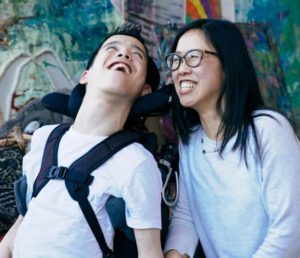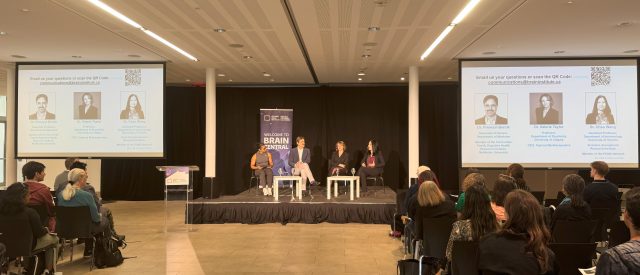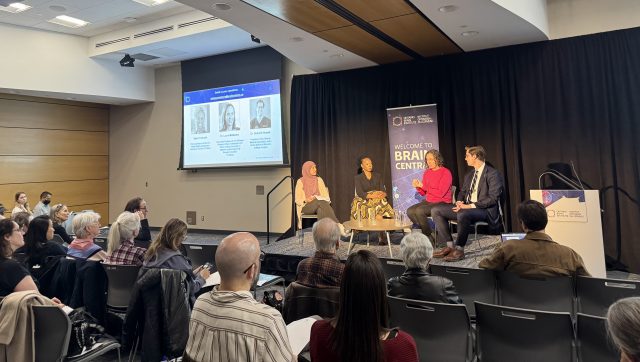
1. Lived experience offers valuable insight on what matters
“Being a part of OBI’s Patient Advisory Committee has provided me the opportunity to increase my own knowledge base while being able to share my opinions and thoughts – the ability to contribute a broader personal perspective, based on my lived experience and professional experience towards research projects” says Shelly LaForest. Shelly is a parent of three – two of whom have epilepsy, a practicing Registered Nurse at The Hospital for Sick Children and a member of OBI’s Data Access Committee and Community Advisory Committee (CAC) for EpLink.
As both a health care practitioner, and a caregiver, Shelly brings a unique perspective when it comes to patient engagement.
“Sometimes, as clinicians, we forget about the burden on carers and what the community needs most urgently” Shelly noted. And for that reason, it becomes increasingly important to voice those needs directly from the people with lived experience, whether its setting research priorities, collecting and reusing data or sharing information with the community.
Brain disorders tend to be chronic conditions, they don’t discriminate by age, gender, or background and people live them their entire life. This is exactly why we need to need to capture diverse perspectives to ensure research is relevant, the questions we are asking address real, unmet needs and offers assistance to the people research intends to help in the first place.
One of the reasons why OBI set up Patient and Community Advisory Committees (PCAC) for it’s six Integrated Discovery Programs (IDPs) is to allow the community is to share insights as a person with livid experience. OBI’s PCAC Committees includes individuals living with brain disorders, care givers, community organizations and representatives, researchers, and support staff from each of the IDPs to integrate their perspectives into research and care.
2. People with lived experience help improve research design
Danny Steeves, a member of our CP-NET Stakeholder Advisory Committee, is the executive producer and host of a YouTube channel called Possibilities. He has been with CP-NET for four years and has helped plan focus groups, webinars, research collecting data on other families who have someone living with cerebral palsy (CP) and identifying commonalities.
Danny feels it’s his responsibility to advocate for people who don’t have a voice. Not everyone with CP is verbal but he is, that’s one reason why he started his own YouTube channel. In high school kids didn’t accept his disability, they just saw his wheelchair. He is adamant that it’s important to see more – to see the person, saying “It’s not about what you can’t do, it’s about what you can”.
Youth are hard to reach and having someone like Danny helps us understand and overcome barriers to their participation. Through his participation Danny has had the opportunity to influence OBI supported initiatives by participating in a study on how to engage youth in research.
He likes to be involved with CP-NET because, in his opinion, it gives more meaning and depth to the research, adding that “It’s important to give people peace of mind in knowing that the study was designed specifically with input from someone with a disability, not just a team of professionals”.
3. They can help shape the information that’s relevant to the community.
The purpose of research is to improve lives. And by working with people with lived experience, we are able to add real world perspective, helps make sure we communicate our findings in language that is understood and in a format they can use.
For Shelly, the key responsibility of OBI-PCAC membership is to make sure that the voice of the affected community is included in research activities, that research questions are relevant for those with lived experience and when communicating with the community we use language that resonates with them.
“CAC members provide input into whether projects are meeting their targets; whether the research questions are relevant, realistic and timely”, she explains. “With EpLink, we actively assisted with knowledge translation activities; ensuring that informational tools would appeal to community members and provided input into research priority setting discussions.”
She also relates how CAC members have influenced discussions centred around stigma with epilepsy, since many, including herself, could provide a first-hand account of how this was impacting their lives and the lives of their families, underlining the urgency for research to improve quality of life.
Whether it’s research papers, guidelines, pamphlets or public talks, by means of these discussions and by engaging patients early on, we can bring to light the issues, concerns or challenges people with lived experience face on an everyday basis, and then effectively share them with the community at large.
What has the patient engagement taught us over the years?
Over the years, OBI has engaged the community in a number of ways, from setting priorities for research to testing technology and assistance with writing guidelines for the community. But here are our key takeaways.
-
- Engage patient/community partners as early in the process as possible when planning activities and when designing studies
- Ensure the purpose and objectives for engaging patient/community partners are communicated clearly and take time to understand how their goals to participate align with the project/activity.
- Maintain consistent engagement with committees by keeping them informed on how their input was used in the decision-making process, and/or considered even if it was not acted upon.
OBI acknowledges the work and efforts of its PCAC members – working in partnership makes us effective, more relevant and more responsive.


